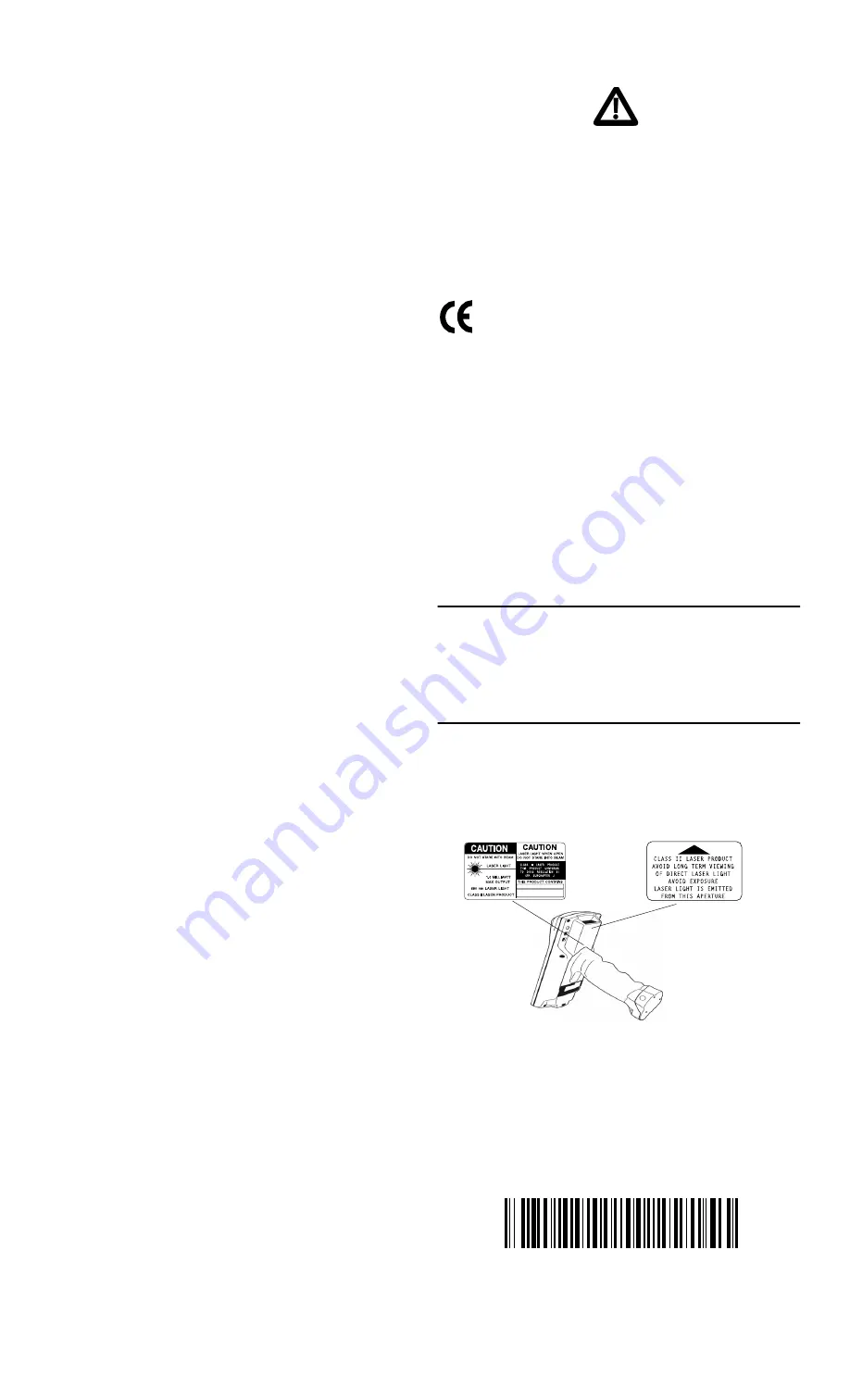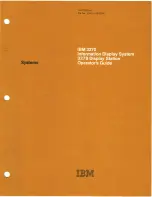
3.
Slide the end cap/battery pack into the handle until the end cap
presses against the body of the handle and the release buttons snap
into place.
4.
Pull on the end cap to make sure it is locked into place.
Maintaining the PTC-960SL-III
Operating conditions
The PTC-960SL-III is designed for use in harsh environments. It can be
operated at temperatures between –4
°
F (–20
°
C) and 122
°
F (50
°
C).
An extended temperature version of the PTC can be operated at
temperatures between –22
°
and 70
°
F (–30
°
to 21
°
C).
• Do not leave the PTC unattended (without being held or operated by
a user) in a freezer environment
(0
°
to –22
°
F/ –18
°
to –30
°
C) for more than 2 hours.
• Do not leave the PTC’s battery pack unattended in a freezer
environment for more than 1 hour as the battery will freeze and
appear to be “dead.” If this occurs, allow the battery to warm up to at
least 65
°
F (18
°
C) before recharging it.
Cleaning the PTC
To clean the PTC-960SL-III, slightly moisten a soft, clean, lint-free cloth
with a mild, nonabrasive cleaner and wipe the outside surfaces. Do not
use a paper towel.
CAUTION!
Do not soak the cloth and do not spray or pour cleaning
liquids directly onto the unit.
Storing the PTC
Do not store the PTC in temperatures below –40
°
F (–40
°
C) or above
167
°
F (75
°
C) or in a damp or humid environment.
1.
Transfer any data stored in the PTC to a host computer or another
PTC or print the data.
2.
Make sure a copy exists of all the PTC’s programs.
3.
Disconnect any accessories from the PTC.
4.
Recharge the PTC’s battery pack or replace it with a charged pack.
5.
Pack the unit in its original packing material or in a padded box and
put it in a safe place away from dust, dirt, humidity, and excessive
heat or cold.
6.
Charge the PTC’s battery pack every two months.
Servicing the PTC
Do not attempt to service the PTC-960SL-III. Only a trained Symbol
technician may service the unit.
Safety information
Using the batteries
Follow these guidelines when handling the PTC’s lithium-ion or nickel-
cadmium battery pack:
• Do not expose the battery pack to water, metal objects, direct
sunlight, extreme heat, or fire.
• Do not attempt to disassemble the battery pack.
• Do not handle a damaged or leaking battery pack.
Disposing of lithium-ion or nickel-cadmium batteries
Lithium-ion and nickel-cadmium batteries contain chemically active
materials that are hazardous to the environment; therefore, they must be
disposed of properly. Never attempt to incinerate a lithium-ion or nickel-
cadmium battery; doing so could cause it to explode. Do not throw away
the battery when it has reached the end of its useful life. Send it to an
authorized battery disposal center for recycling according to country,
federal, state and local laws.
If your PTC contains a radio:
This device is compliant to the ANSI C95.1 (1992) Standard for Safety
Levels with Respect to Human Exposure to Radio Frequency
Electromagnetic Fields per FCC Docket 93-62.
Radio Frequency Interference Requirements
This device has been tested and found to comply with the limits for a Class B digital device
pursuant to Part 15 of the Federal Communications Commissions Rules and Regulation.
These limits are designed to provide reasonable protection against harmful interference
when the equipment is operated in a commercial environment. This equipment generates,
uses, and can radiate radio frequency energy and, if not installed and used in accordance
with the instruction manual, may cause harmful interference to radio communications.
Operation of this equipment in a residential area is likely to cause harmful interference in
which case the user will be required to correct the interference at his own expense.
However, there is no guarantee that interference will not occur in a particular installation. If
the equipment does cause harmful interference to radio or television reception, which can be
determined by turning the equipment off and on, the user is encouraged to try to correct the
interference by one or more of the following measures:
• Re-orient or relocate the receiving antenna.
• Increase the separation between the equipment and receiver.
• Connect the equipment into an outlet on a circuit different from that which the receiver
is connected.
• Consult the dealer or an experienced radio/TV technician for help.
This device complies with FCC Part 15. Operation is subject to the following two conditions:
(1) this device may not cause harmful interference and (2) this device must accept any
interference received, including interference that may cause undesired operation.
Important Note: To comply with FCC and Industry Canada RF exposure requirements, this
hand-held device is approved for operation in a user's hand when there is 20 cm or more
between the antenna and the user's body.
Radio Frequency Interference Requirements - Canada
This device complies with RSS 210 of Industry & Science Canada. Operation is subject to
the following two conditions: (1) this device may not cause harmful interference and (2) this
device must accept any interference received, including interference that may cause
undesired operation.
This Class B digital apparatus complies with Industry Canada Standard ICES-003.
Cet appareil numérique de la classe B est conform à la norme NMB-003 d’Industrie Canada.
CE Marking and European Union Compliance
Products intended for sale within the European Union are marked with the CE
Mark which indicates compliance to applicable Directives and European
Normes (EN). Amendments to these Directives or ENs are included:
Applicable Directives
• Electromagnetic Compatibility Directive 89/336/EEC
• Low Voltage Directive 73/23/EEC
RF Devices
Symbol’s RF products are designed to be compliant with the rules and regulations in the
locations into which they are sold and will be labeled as required. The majority of Symbol’s
RF devices are type approved and do not require the user to obtain license or authorization
before using the equipment. Any changes or modifications to Symbol Technologies
equipment not expressly approved by Symbol Technologies could void the user’s authority
to operate the equipment.
The Spectrum24 equipment is intended for use throughout the European Economic Area,
but its authorization for use in France is restricted as follows:
•
PAN European Frequency Range:
2.400 - 2.4835 GHz, identified by -EU suffix to the
model number found on the product label
•
France
- Restrict Frequency Range for use in France: 2.4465 - 2.4835 GHz, identified
on [Product mmmm] by the -FR suffix to the model number found on the product label
•
Belgium
- Operation in an out of doors environment in Belgium must be restricted to
2.460 - 2.4835 GHz band
•
Italy
- Operation in Italy requires a user license
•
Mexico
- Restrict Frequency Range for use in Mexico: 2.450 - 2.4835 GHz
•
Chile
- Restricted Power Output for use in Chile: 50 mW
Caution:
Handheld Devices: FCC RF Exposure Guidelines
To satisfy FCC RF exposure compliance requirements for a mobile transmit-
ting device, this device should be used in hand-held, hand-operated configu-
rations only. The device and its antenna should generally maintain a
separation distance of 20 cm or more from a person's body; except for the
hands and wrists because of higher exposure limit for extremities. This device
is designed to be used in a person's hands and its operating configurations,
generally do not support normal transmissions while it is carried in pockets or
holsters next to a person's body.
Laser Devices
Class 1 Laser devices are not considered to be hazardous when used for their intended
purpose. The following statement is required to comply with US and international regulations:
Caution
: Use of controls, adjustments or performance of procedures other than those
specified herein may result in hazardous laser light exposure.
Scanner Labelling
Symbol is a registered trademark of Symbol Technologies, Inc.
The information contained on this sheet is subject to change without notice. Corpora-
tion shall not be liable for technical or editorial omissions or mistakes on this sheet
nor shall it be liable for incidental or consequential damages resulting from your use
of the information contained on this sheet.
This sheet is copyrighted. All rights are reserved. No part of this sheet may be photo-
copied or reproduced in any form without the prior written consent of Symbol Tech-
nologies.
© Copyright 1997 Symbol Technologies, Inc., One Symbol Plaza, Holtsville, NY
11742-1300.
Symbol Support Center: 1-800-653-5350.
\All rights reserved.
72-52929-01
Revision A— June 2001




















